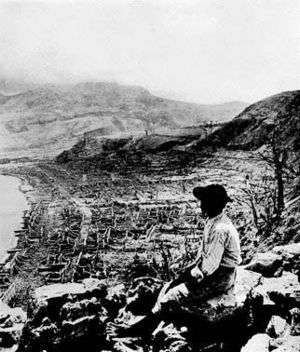Saint-Pierre, Martinique
Saint-Pierre (French pronunciation: [sɛ̃ pjɛʁ]) is a town and commune of France's Caribbean overseas department of Martinique, founded in 1635 by Pierre Belain d'Esnambuc. Before the total destruction of Saint-Pierre in 1902 by a volcanic eruption, it was the most important city of Martinique culturally and economically, being known as "the Paris of the Caribbean". While Fort-de-France was the official administrative capital, Saint-Pierre was the cultural capital of Martinique. After the disaster, Fort-de-France grew in economic importance.
Saint-Pierre | |
|---|---|
Subprefecture and commune | |
Saint-Pierre, with Mount Pelée in the background | |
.svg.png) Coat of arms | |
Location of the commune (in red) within Martinique | |
Location of Saint-Pierre 
| |
| Coordinates: 14°44′30″N 61°10′33″W | |
| Country | France |
| Overseas region and department | Martinique |
| Arrondissement | Saint-Pierre |
| Government | |
| • Mayor (2015–2020) | Christian Rapha |
| Area 1 | 38.72 km2 (14.95 sq mi) |
| Population (2017-01-01)[1] | 4,123 |
| • Density | 110/km2 (280/sq mi) |
| Time zone | UTC−04:00 (AST) |
| INSEE/Postal code | 97225 /97250 |
| Elevation | 0–1,397 m (0–4,583 ft) |
| 1 French Land Register data, which excludes lakes, ponds, glaciers > 1 km2 (0.386 sq mi or 247 acres) and river estuaries. | |
History
Saint-Pierre was founded in 1635 by Pierre Belain d'Esnambuc, a French trader and adventurer, as the first permanent French colony on the island of Martinique.
The Great Hurricane of 1780 produced a storm-surge of 8 metres (25 ft) which "inundated the city, destroying all houses" and killed 9,000 people.[2]
Eruption of Mount Pelée

The town was again destroyed in 1902, when the volcano Mount Pelée erupted, killing 28,000 people. The entire population of the town, as well as people from neighboring villages who had taken refuge in the supposedly safe city, died, except for two people—a prisoner by the name of Louis-Auguste Cyparis (known also by various other names), who later toured the world with the Barnum and Bailey Circus, and Léon Compère-Léandre, who lived at the edge of the city.[3][4][5]
Legend has it that the town's doom was forecast by loud groaning noises from within the volcano, but the mayor of the town had it blocked off to prevent people from leaving during an election. This story appears to have originated with one of the island's newspapers, published by a political opponent of the governor. Actually, there was considerable eruptive activity in the two weeks prior to the fatal blast, but since the phenomenon of the pyroclastic flow (French: nuée ardente) was not yet understood, the danger was perceived to be from lava flows, which, it was believed, would be stopped by two valleys between the volcano and the city.
.jpg)
Today
The city of Saint-Pierre was never restored to its former entirety, though some villages were built in later decades on its place.
Today, the town is the district capital of the Caribbean North district of Martinique. It has been designated as a "City of Art and History". There are many historic remains, and a Volcanological Museum (Musée vulcanologique Franck Perret).
See also
- Co-Cathedral of Our Lady of Assumption, Saint-Pierre
- Communes of the Martinique department
- Herculaneum
- Pompeii
- Victor Cochinat (1819–1886), French journalist
- Georges Hébert (1875–1957), French naval officer who witnessed the destruction by the volcano on the island in 1902, and went on to develop a physical training method from his experience
References
- "Populations légales 2017". INSEE. Retrieved 6 January 2020.
- Orlando Pérez (ed.). "Notes on the Tropical Cyclones of Puerto Rico, 1508��?970". p. 11. Atlantic Oceanographic and Meteorological Laboratory.
- International, Ripley (1982). "Volcanoes". Ripley's Believe It or Not Great Disasters. Ripley's Believe It or Not. New York: Pocket. p. 17. ISBN 0-671-46220-2.
- Garesche, William A. (1 March 2007). "The Destruction of St Pierre, Martinique". Complete Story of the Martinique and St Vincent Horrors. READ BOOKS. pp. 48–0. ISBN 978-1-4067-5983-9. Retrieved 10 June 2010.
- Ernest Zebrowski (2002). The last days of St. Pierre: the volcanic disaster that claimed thirty thousand lives. Rutgers University Press. ISBN 978-0-8135-3041-3.
External links
- Mérimée database - Cultural heritage (in French)
- City of Saint-Pierre description from English edition of official Martinique website
| Wikimedia Commons has media related to Saint-Pierre (Martinique). |